Aestivation
Aestivation Definition: The pattern of arrangement of calyx, corolla or perianth in a flower bud is known as aestivation.
Aestivation Types:
Different types of aestivation are as follows—
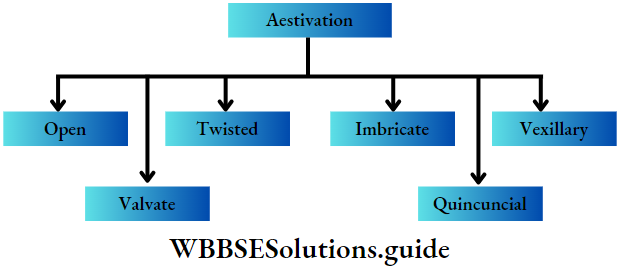
Open: The margins of the sepals or petals do not touch or overlap each other. example Magnolia champaca, Allaria sp., etc.
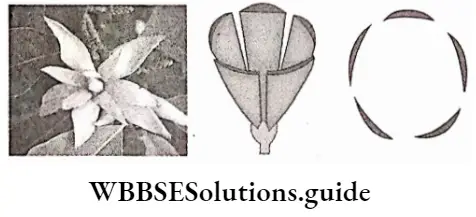
Valvate: The margins of sepals or petals just touch side by side closely, without overlapping each other. example, calyx of Hibiscus rosa-sinensis, both calyx and corolla of Mimosa pudica and Acacia nilotica, etc.
Read and Learn More: WBCHSE Notes for Class 11 Biology
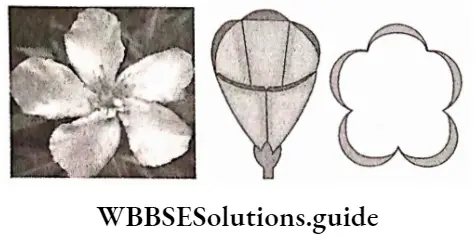
Twisted or contorted: One margin of each sepal or petal overlaps the margin of the neighboring sepal or petal. example corolla of Hibiscus rosa-sinensis, Nerium odoratum, etc.
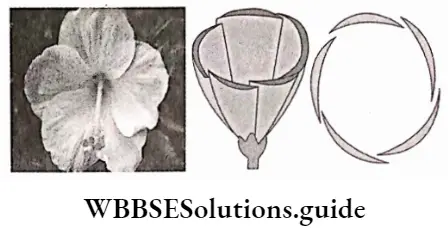
Imbricate: One member of the whorl remains completely outside without any overlapping both the edges of another member remain overlapped by the neighboring members and the rest are arranged in a twisted manner. example corolla of Solanum torvum, Nicotiana tabacum, Clerodendrum viscosum, etc.
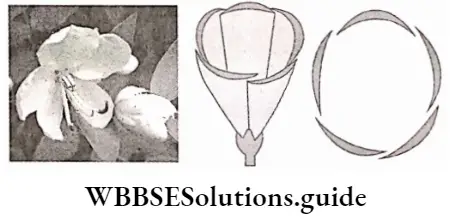
Quincuncial: Two members of the whorl remain completely external and two remain completely internal. The rest are present in a twisted manner. example petals of Lantana camara, sepals of Holarrhena antidysenterica, etc.
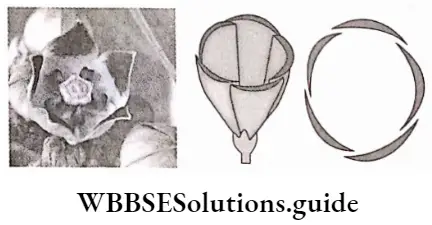
Vexillary: Out of five members the posterior single petal is the largest and outermost (vexillum), which overlaps the two lateral petals (wings). The two wings partially overlap the two smallest and innermost, partially fused petals (keel). example corolla of Pisum sativum, Clitoria ternatea, Crotolaria sp., etc.
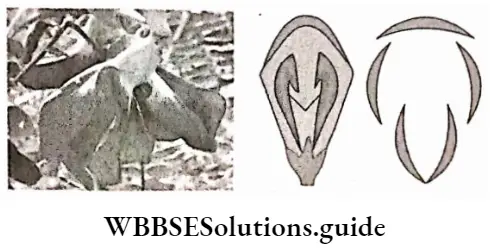
Variations Infloral Members
The floral parts, i.e., calyx, corolla, androecium, and gynoecium, show different variations in their shapes, position, arrangement, and association with other floral parts. These variations or forms of different floral members are described below.
Variation in calyx
Different types of sepals are discussed below.
Based on the color of the calyx: According to the color of sepals, calyx are of two types. The green-coloured calyx is known as sepaloid. example, Cocos nucifera. Sometimes the calyx becomes colored like the petals and is known as a petaloid or tepal. example Mussaenda sp.
Based on whether sepals are united or not: According to the union of sepals, calyx are of two types.
Polysepalous: In this type, the sepals remain free and separate. example Brassica nigra.
Gamosepalous: In this type, the sepals remain partially or completely united. example Datura metel, Hibiscus rosa-sinensis.
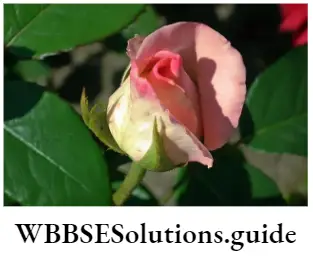
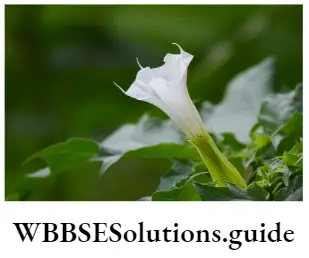
Based on the duration of attachment of calyx to the flower: According to the duration of attachment of calyx to the flowers, calyx are of two types.
Caducous or fagacious: It sheds off just before the complete blooming of the flower. example Papaver somniferum.
Deciduous: It remains attached to the flower until fertilization. It sheds off with corolla. example Brassica nigra.
Persistent: It remains attached till fruit maturation and never sheds off. It is of two types—
Marcescent: This type of persistent sepals cease further growth after fertilization, get shrunk, and become wrinkled. example Solarium melongena.
Accrescent: This type of persistent sepals continues to grow along the growth of the fruit. example Cocos nucifera, and Dillenia indica.
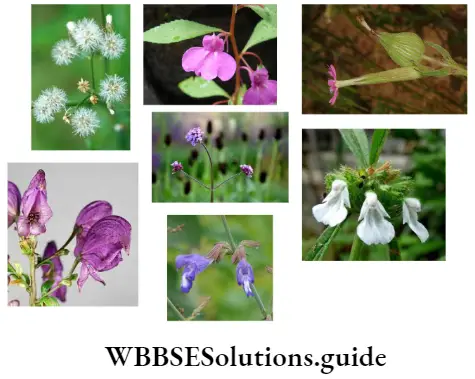
Based on the structure of calyx: The structure of calyx varies with species. Types of calyx based on their structures have been mentioned.
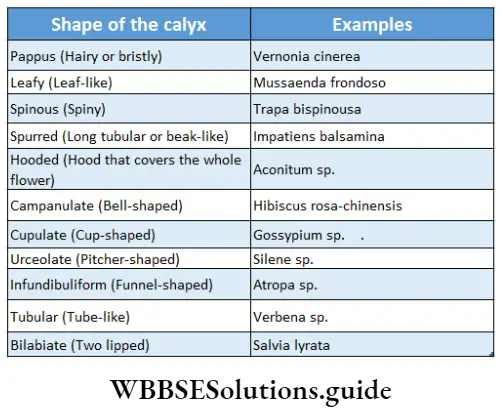
Variation In Corolla
On the basis of different characters corolla can be of various types. Sometimes the petals can be green in color, known as sepaloid or sepaline. example Annona squamosa, Pergularia daemia, etc.
Based on whether petals are united or not: According to the union of petals, corolla are of two types—
Polypetalous: The petals remain free. example Brassica nigra.
Gamopetalous or sympetalous: The petals are completely or partially united. example Datura metel, Catharanthus roseus, etc.
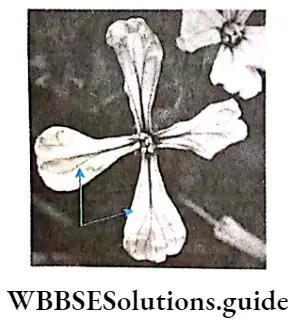
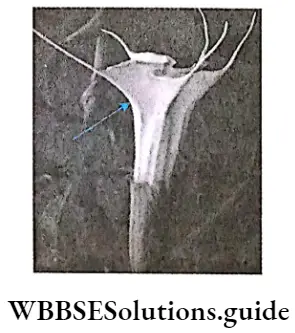
Appendages of Corolla
Sometimes various types of appendages may develop on the corolla.
These are as follows—
- Saccate or gibbous: This is a sac-like or pouch-like structure formed by the dilation of the lower region of the corolla tube on one side. example Antirrhinum majus (snapdragon), Calceolaria mexicana.
- Corona: These are hair-like or scaly outgrowths of various kinds that develop from the inner wall of the corolla tube. example Passiflora suberosa, Nerium indicum, Scoparia dulcis, etc.
- Spurred or calcarate: These are tubular structures formed by the elongation of a single petal or petals of the corolla tube. example Delphinum majus and Aquilegia sp.
Based on the structure of corolla:
According to the structure, corollas are of the following types—
Polypetalous and regular type:
This type of Corolla is divided into three types—
- Cruciform: In this type, four clawed free petals are arranged in the form of a cross. example Brassica nigra (mustard) and Raphanus sativa (radish), etc.
- Caryophyllaceous: In this type, five petals have claws, arranged at right angles to their limbs. example Dianthus chinensis and Saponaria vaccaria, etc.
- Rosaceous: In this type, five or more almost sessile petals are widely spread outside. example Rosa lucida (wild rose), and Camellia sinensis (tea).
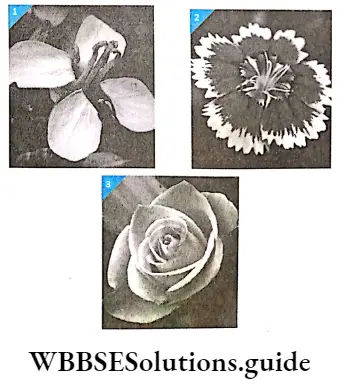
Polypetalous and irregular type: Out of five irregular free petals, the posterior, odd petal is the largest and outermost. This is known as vexillum or standard. The vexillum overlaps two lateral petals, known as wings or alae.
The wings partially overlap the two smallest and innermost petals known as keel or carina. These two interior petals remain more or less united. It is also known as a papilionaceous type of corolla. Examples are Pisum sativum (pea), Sesbania grandriflora, Clitoria ternatea, etc.
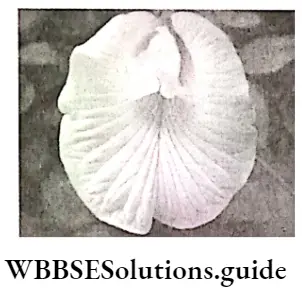
Gamopetalous and irregular type:
This type of Corolla is of three types—
- Ligulate: Five petals unite to form a flat tongue-shaped upper part of the corolla gradually forms the short tubular lower part. example, Ray florets of Helianthus annuus (sunflower).
- Bilabiate or two-lipped: The upper part of the corolla tube is divided into two lip-like structures to form a wide open mouth above the throat. example Ocimum sanctum, Anisomeles indica, Leucas linifolia.
- Personate or masked: The flower contains, a bilabiate corolla limb, but here the mouth is closed by a projection (palate) of the lower lip. example Antirrhinum majus (snapdragon), Lindenbergia indica, etc.
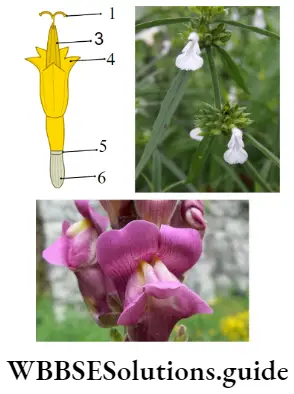
Gamopetafous and regular type:
This type of corolla is divided into the following types—
- Tubular: Here, the petals unite to form a cylindrical corolla tube. example Disc florets of Helianthus annuus (sunflower).
- Campanulate or bell-shaped: The petals unite to form a bell-shaped structure. example Cucurbita maxima (pumpkin), Thevetia peruviana (yellow oleander), Physalis peruviana, etc.
- Rotate or wheel-shaped: The short corolla tube spreads its flat limbs at right angles to the tube axis example Scoparia dulcis, Solanum melongena (brinjal), Calotropis procera, etc.
- Hypocrateriform or salver-shaped: The long and narrow corolla tube spreads its limbs at right angles to the tube axis. The limbs arrange themselves in a wheel-like structure. example. Ixora coccinea, Ipomoea quammoclit,etc.
- Infundibuliform or funnel-shaped: The lower tubular corolla gradually widens at the top like a funnel. example, Ipomoea pulchella (morning glory), and Datura sp. (thorn apple).
- Urceolate or urn-shaped: The corolla tube becomes inflated in the middle and comparatively narrower at both ends. example Rhododendron sp., Bryophyllum calycinum.
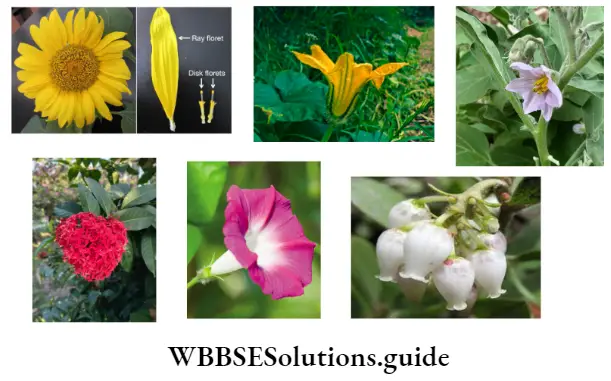
Variation in androecium
On the basis of the number, location, structure, etc. of stamen, androecium is of different types.
Based on the number of other lobes:
Based on the number of enter lobes, androecia are of the following types—
Monothecous: Anthers have a single lobe. Example Brassica nigra.
Dithecous: Anthers have two lobes. Example Hibiscus rosa-sinensis.
The number of stamens varies from one to many. On the basis of the number of stamens,
The flowers are grouped as—
- Monandrous: This type of flower contains single or solitary stamen. Example Curcuma longa (turmeric).
- Diandrous: This type of flower contains two stamens. Example Adhatoda vasica (vasaka).
- Triandrous: This type of flower contains three stamens. Example Triticum aestivum (wheat).
- Tetrandrous: This type of flower contains four stamens. Example Ocimum sanctum (tulsi).
- Pentandrous: This type of flower contains five stamens. Example Solanum nigrum.
- Hexandrous: This type of flower contains six stamens. Example Oryza sativa.
- Polyandrous: This type of flower contains numerous stamens. Example Rosa centifolia.
Based on the insertion of stamens:
Based on the insertion of stamens, androecia are of the following types—
Isostemonous: In this type, one whorl of stamens is arranged alternately with the sepals i.e., antisepalous (Example Pisum sativum) or petals i.e., antipetalous (Example Primrose)
Diplostemonous: In this type, the stamens are arranged in two whorls and the number of stamens is double the number of petals. Usually, the inner whorl remains opposite to the petals. Example Cassia’s fistula.
Obdiplostemonous: In this type, the stamens are arranged in two whorls such that the members of the outer whorl are opposite to petals and those in the inner whorl are opposite to sepals. Example Geranium sp.
Polystemonous: In this type, stamens are arranged in more than two whorls. Example Delphinium sp.
Alternipetalous: In this type, the stamens remain opposite to the perianth. Example Diosporous embryopteris.
Based on the length of the stamen:
Based on the length of stamens, androecia are of the following types—
Didynamous: There is a solitary whorl of four stamens, among which two stamens are longer than the other two. Example Leonurus sibiricus.
Tetradynamous: Six stamens are arranged in two whorls. In the outer whorl, two stamens are there which are shorter than the four stamens of the inner whorl. For example, Brassica nigra.
Heterodynamous: In this type, stamens of different lengths occur in one whorl. Example Cassia Tora.
Based on the attachment of anther with the filament:
According to the attachment of anther with filament, stamens are of the following types—
Adnate: The filament remains attached throughout the length of the anther. Example Magnolia sp.
Basifixed or innate: The apex of the filament remains firmly attached to the base of the anther. Example Brassica sp.
Dorsifixed: The tip of the filament remains firmly attached to the dorsal side of the anther. Examples are Sesbania sp., Passiflora sp.
Versatile: The tip of the filament remains attached at a point near the middle of the connective and thus the anthers can move freely. Example Triticum aestivum.
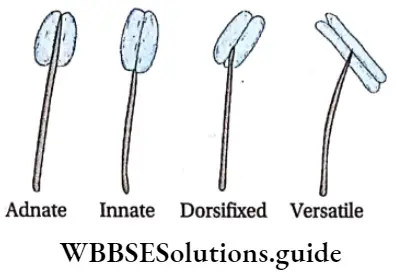
Based on the shape of the anther: Different types of anthers, based on their shapes are given below.
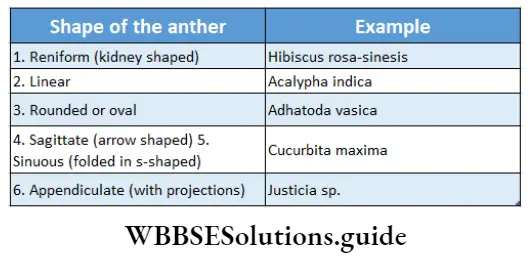
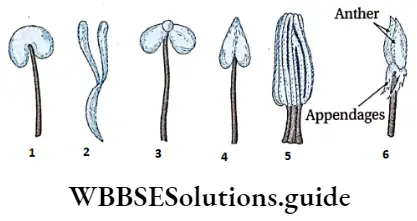
Based on the dehiscence of anthers: The pollen grains inside the mature anther develop and exert some pressure on the outer wall. The anther wall bursts open due to the pressure and the pollen grains are set free in the air.
The dehiscence pattern of anthers can be of the following types—
Longitudinal: The anther lobes burst longitudinally. This occurs along the line of suture from base to apex. Example Datura sp.
Transverse: The anther splits up transversely along the suture. Example Hibiscus rosa-sinensis.
Apical or porous: The pollen grains are discharged through the apical pores of the anther. Example Solarium tuberosum.
Valvular: The walls of the anther open up like valves to discharge the pollens. Examples are Berberis vulgaris, Cinnamomum zeylanicum, etc.
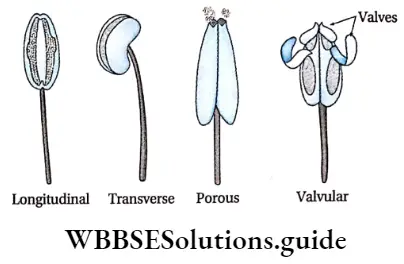
Based on the union of stamens: The stamens may be fused with each other or with the gynoecium or perianth.
The union of stamens found in different flowers is of the following types—
Cohesion of stamen: Stamens may remain fused with each other or with filament or another. This is known as the cohesion of stamen.
This can be of the following types—
1. Adelphous: In this type, the stamens are united by the fusion of their filaments.
The adelphous condition may further be divided into the following types—
- Monadelphous: In this type, filaments of all the stamens are fused to form a single tubular structure. Example Hibiscus rosa-sinensis.
- Diadelphous: In this type, the stamens are fused at their filaments and form two bundles. Example Pisum sativum.
- Polyadelphous: In this type, the stamens are fused by their filaments and form more than two groups. Example Bombax ceiba.
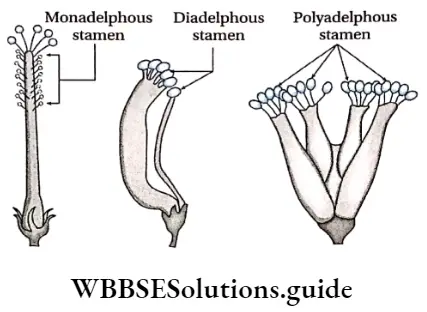
2. Syngenesious: In this type, all the anthers remain fused but the filaments are free. Example Helianthus annuus (sunflower).
3. Synandrous: In this type, the anthers and filaments are fused throughout their length to form a compact structure. Example Cucurbita maxima (pumpkin).
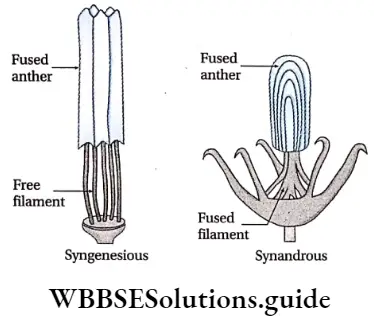
Adhesion of stamens: When the stamens are attached with other floral whorls or perianth, then the condition is known as adhesion of stamen.
it is classified into the following types—
- Epipetalous stamen: The stamens remain attached to the petals by their filaments. Example Solanum nigram.
- Epiphyllous stamen: The stamens are attached to the perianth by their filaments. Example Polyanthes tuberosa (tuberose).
- Gynandrous stamen: The stamens remain attached to the gynoecium, either throughout their length or only by their anthers. Example Calotropis sp.
- Episepalous stamen: The stamens remain attached to the calyx. Example Quinsqualis sp.
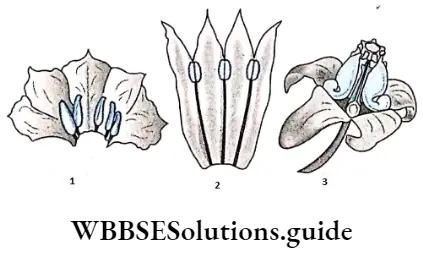
Variation in Gynoecium
Based on the number and position of the thalamus, the gynoecium is of various types.
Based on the number of carpels in the gynoecium:
According number of carpels, gynoecium are of the following types—
Simple or monocarpellary gynoecium: The gynoecium is composed of solitary carpel. Example Pisum sativum.
Bicarpellary: The gynoecium is composed of two carpels. Example Justicia sp.
Tricarpellary: The gynoecium is composed of three carpels. Example Allium cepa.
Tetracarpellary: The gynoecium is composed of four carpels. Example Datura metel.
Pentacarpeliary: The gynoecium is composed of five carpels. Example Melia sp.
Compound or polycarpellary: The gynoecium is composed of more than five carpels. Example Papaver sp. It is of the following two types, on the basis of their union—
Apocarpous: In this type, the carpels remain completely free from one another to form multiple ovaries. Example Michelia Champaca.
Syncarpous: In this type, the carpels are fused with each other to form a single ovary. Example Mangifera indica.
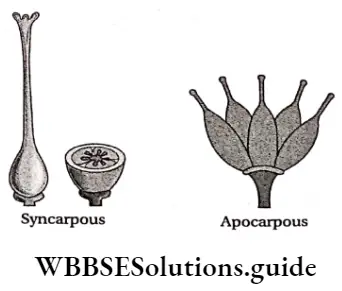
Based on the number of locules in the ovary: According to the number of locules or chambers in the ovary,
Gynoecium can be of the following types—
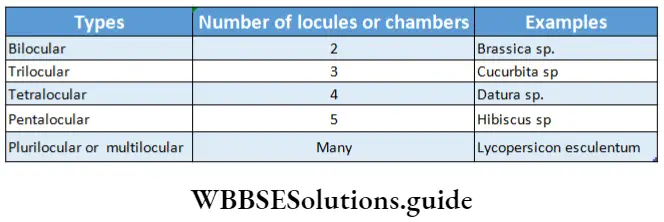
Based on the position of the ovary on the thalamus: The position of the ovary on the thalamus varies in plants.
Superior: In this type, the ovary is situated on the top of the thalamus and the other floral whorls reside just below the ovary. The flowers which bear this type of ovary are known as hypogynous flowers. Example Hibiscus rosa-sinensis.
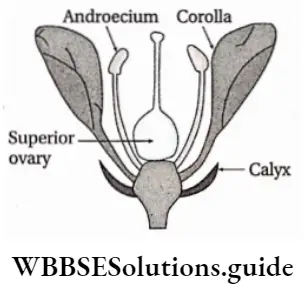
Inferior: In this type, the ovary resides at a level that is lower than the other floral whorls on the thalamus. The thalamus becomes cup-shaped due to fusion with the ovary wall. The flowers which bear this type of ovary are known as epigynous flowers. Example Cucurbita maxima.
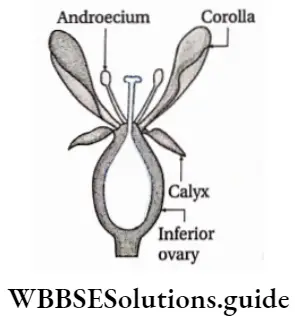
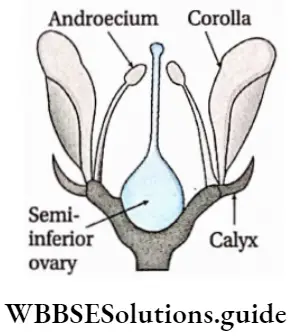
Semi-inferior: In the type, the ovary is situated in such a position, which is intermediate to that of the superior and inferior types. the flowers that bear this type of ovary are known as perigynous flowers example pisum sotivum.

